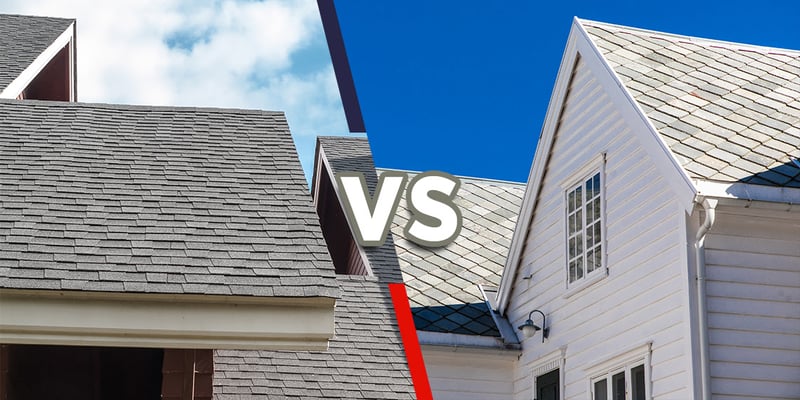- Home »
- Learningcenter »
- Class 3 4 shingles
Class 3 vs Class 4 Shingles: What Do These Mean?

I can totally relate to the differences in how homes handle the chaos of a big hailstorm. I've seen that some houses in my neighborhood look almost new afterward while others really show damage. This usually depends on the type of roofing shingles they use. A few years ago, I had my own surprise with roofing. Until that point, I hadn't paid much attention to what shielded my house from the weather - learning about Class 3 and Class 4 shingles was a real eye-opener! These shingles stand up to bad weather really well.
So now, let's talk about the space of roofing shingles. We'll look at some great options that can stop some big headaches when storm season hits - are you curious about how a smart choice now could stop a lot of trouble later?
Let's get started!
What Is The UL 2218 Change Resistance Test?
When I was picking shingles for my roof, understanding their resistance to hail was really important to me. Now, there's the UL 2218 Change Resistance Test, which really helps. It tests the toughness of different roofing parts by dropping a steel ball on them - similar to how hail hits during a storm.
Here's how it works: they drop a steel ball meant to simulate hail from a certain height onto the shingle. You get different ratings from this test. Just to give you a quick example - Class 3 shingles can handle a 1.25-inch ball dropped from 17 feet, while Class 4 shingles are stronger and endure a 2-inch ball dropped from 20 feet.

Living in a hail-prone area, I've seen the outcomes of picking the right or wrong shingle type. My neighbor installed Class 4 shingles, and it really made a difference during a severe hailstorm. He had much less damage compared to another friend who had Class 3 shingles. It was pretty clear that investing a bit more upfront for stronger shingles meant fewer problems and costs later.
It also relates to sticking to building codes that change by area. Usually, going for higher-class shingles means you either meet or exceed local safety standards.
For me, picking shingles with good change resistance feels like buying peace of mind. I think I'm doing all I can to protect my house. After all, fixing your house after a storm can be a big problem both in time and money, so I believe it's totally worth it to get the best shingles you can.
The Durability of Class 3 Shingles
Class 3 shingles go through tests with steel balls about 1.75 inches in diameter launched at speeds up to 60 mph. From what I've seen, they handle the change pretty well. They're like the middleweight champion of shingles: not the toughest, but definitely far from the weakest.
Many people I know use Class 3 shingles when it's time for a roof update. Take my friend who recently made some home improvements - he went with Class 3 because, in his area, hail happens just enough to be annoying but not so much that he needs the most heavy-duty option. He thought, why spend more on protection he doesn't really need? Honestly, I think he made a smart choice.

If you're in a place with moderate weather, picking Class 3 could be just right. They're made to handle hail and high winds, which can be a real headache if you're unprepared. In my view, it's a smart pick if you're after something affordable yet still reliable.
Besides, it's a choice that'll likely save you money in the long run and keep your house safe from those occasional storms. When it comes to finding the perfect balance between performance and budget and for many Class 3 does just that.
The Durability of Class 4 Shingles
When I first found out about Class 4 shingles, I was impressed by their toughness in the roofing industry, especially since they need to handle a lot of stress. These shingles undergo severe testing to earn the Class 4 rating. They must stand up to a 2-inch steel ball dropped from 20 feet up multiple times and still stay intact. That's very solid, right?
From my experience, the toughness of these shingles is important during hail storms, which can be a nightmare if they're common in your area. These shingles can manage hail that might dent or even crack other types. It's reassuring to have something so sturdy protecting your home, extending your roof's life, and cutting the frequency of repairs or replacements.

These shingles usually add a 50-year warranty, which is much longer than for lower-class shingles. This is appealing if you're planning for the long term. With less repairs needed, you save money and worry less about your roof, which is a big benefit.
They also meet the top standards for fire resistance.
Here's a financial tip - because of their strength, having Class 4 shingles on your home might get you a discount on homeowners insurance. Since the risk of damage claims is lower insurers might see your home as a safer bet.
From both a cost-efficiency and protection point of view Class 4 shingles are a smart choice because of their strength and return on investment. They might cost more upfront but the long-term savings make them a worthwhile investment. It's kind of like buying a reliable shield for your biggest asset - your home.
Do Class 4 Shingles Justify the Extra Cost?
Understanding the differences between shingle classes might not seem exciting unless you've had to replace your roof sooner than planned because of storm damage. That's when it really hits you how important it is to know what Class 4 shingles give compared to the usual options.
Class 4 shingles handle tougher weather conditions like strong winds and hail better than regular asphalt shingles. With Class 4, you pay about 10-25% more, which means for a typical job, you might spend anywhere from $4,960 to $8,950 for parts and labor. Initially, this price increase might make you hesitate when you think about your budget, but let's look at what that extra money gives.
The tough nature and longer lifespan of Class 4 shingles can make a big difference, especially if storms frequently target your area. These shingles stand up to hail and can cope with winds as fast as 110 mph. Dealing with fewer storms means having fewer repairs and owning a longer-lasting roof. I personally feel way more relaxed knowing my roof has that extra protection, especially during intense summer storms.

Then there's the chance for insurance discounts, which can be pretty enticing. Depending on where you live and your insurance details, picking Class 4 could cut your premiums by 20-28%. But as I found in a recent Reddit thread, not everyone gets these discounts - it really depends on your policy and local insurance regulations.
When it comes to installation, you might think these super strong shingles would be more expensive to install. Fairly, the installation costs are about the same as those for regular asphalt shingles. Sometimes Class 4 shingles are even easier to put up, which could help you save on labor costs, and that's always a welcome bonus when handling home improvement costs.
If you're thinking about switching to Class 4 shingles, I'd say it's worth it when you think about how the benefits line up with your specific situation and place. To give you an example, if you live in a region that gets a lot of hail, upgrading might be an obvious choice. But if your area usually has calm weather, you might choose differently after weighing the costs and benefits. Thinking about possible insurance savings, better durability, and how it could help with your home's resale value, Class 4 shingles present a strong case. But, the needs of each homeowner will affect the decision.
What About Class 1 and 2 Shingles?
When it comes to picking out roofing parts, specifically shingles, it's really important to think about their hail resistance rating. I always talk about this with my clients, especially those living in areas where the weather can get pretty rough. Picking the right type of shingle can really change how well a roof withstands unexpected hail storms.
On how these shingles get their ratings. A test that means dropping steel balls on them simulates hail to see how well they hold up.
Class 1 shingles must stand up to a 1.25-inch diameter steel ball, while Class 2 shingles face a slightly bigger 1.5-inch ball. Both types are tested from 20 feet up to make sure they're tough enough for real-life conditions.

From my experience, if you're in an area that doesn't see large hailstones, Class 1 shingles usually work well. But in places where the hail gets bigger than 1.5 inches, you'll want to choose Class 2. The difference in protection is noticeable, and many homeowners have thanked me after a big storm for recommending the sturdier option.
Interestingly, these ratings don't just help keep your house safe - they can also save you some money on insurance. Many insurance companies give discounts on your premiums if your roof has higher-class shingles because they're less likely to get damaged. It's a win: you get a stronger roof and save some cash at the same time.
In my opinion, it's always better to use the best protection you can afford, especially for something as important as your roof. It's the main barrier between nature and your comfy home, so skimping on quality isn't wise. Besides, investing in better shingles now could save you from steep repair bills later. That's just my two cents!
Insurance Benefits and Change Resistance
When I first started looking into Class 3 and Class 4 shingles, I was really attracted by the insurance benefits they offered. You know, picking these impact-resistant shingles could actually cut my homeowners' insurance costs - a constant lookout for me to keep costs in check. Depending on where you live and who your insurer is, you might see discounts from 5% to 35%. The reasoning here is pretty easy: tougher shingles mean less risk of damage in rough weather, leading to a more favorable risk assessment for your home.

But costs are a mixed bag. While the potential insurance discounts are appealing, the upfront cost for Class 3 or Class 4 shingles is really a bit higher than for the more standard options. The reason is that their manufacturing process is more complete, and they use more sophisticated parts that raise the price.
Even though the cost is higher, I think the investment is worth it. Over time, the improved durability of these shingles means less repairs and replacements - which is great for someone like me who would enjoy the weekend not spending it fixing the roof. Also, they're better for energy efficiency, which could help lower those climbing heating and cooling bills.
But there's a catch - insurance coverage for what's called "cosmetic" damage. From what I've found out, some policies might not cover minor cosmetic damage to these high-grade shingles under a "cosmetic exclusion" clause. Basically, if hail hits your roof but doesn't affect its structural strength, you might not get anything for damage that's still pretty noticeable.
Personally while the idea of not getting every dent covered annoys me a bit I balance it against the long-term savings and increased safety these shingles give. It seems like a small compromise for keeping my home more secure and possibly cutting down on insurance costs down the line.
Protect The Roof Over Your Head
Let's talk about picking the right roofing parts, especially when you think about the weather. Making these choices can be difficult, like picking what to wear based on the forecast. Where I'm from in Tornado Alley, picking for Class 4 shingles is a no-brainer. These shingles are tough and hold up well against hail, which really helps keep those repair costs down in the long run. Honestly, I sleep better knowing I have them on my roof when the sky starts looking threatening.
If you're in a region where intense storms and hail are rare, Class 3 shingles might be the way to go. They give you solid protection and can even save some money. I always think it's wiser to make your home for what might come than deal with damages later. It makes sense, doesn't it?

So, how about letting our team at Colony Roofers help? We give you impressive roofing services in places like Georgia, Florida, and Texas if it's for your business or your personal space. Feeling swamped? Well, think about taking benefit of our free roof inspection. Speaking with an expert can really clear up any confusion about what you might need. Why not give us a call today? We're excited to show you why picking us means keeping your roof in peak condition.
 Call (678) 365-3138
Call (678) 365-3138



